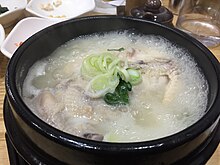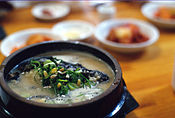User:Donghoka/sandbox
 | |
| Alternative names | Ginseng chicken soup |
|---|---|
| Type | Tang |
| Place of origin | Korea |
| Serving temperature | Hot or Warm |
| Main ingredients | Chicken, ginseng |
| Ingredients generally used | Jujube, glutinous rice |
| Korean name | |
| Hangul | 삼계탕 |
|---|---|
| Hanja | 蔘鷄湯 |
| Revised Romanization | samgye-tang[1][2] |
| McCune–Reischauer | samgye-t'ang |
| IPA | [sam.ɡje̞.tʰaŋ] |
Samgye-tang (삼계탕; 蔘鷄湯) or ginseng chicken soup,[1] meaning ginseng (kor. sam) - chicken (kor. gye) - soup (kor. tang) in Korean, consists primarily of a whole young chicken (poussin) - filled with garlic, rice, jujube, and ginseng.[3] Samgye-tang is a Korean traditional soup for body health.

Origins and history[edit]
Samgyetang is a warm soup for hot summer days. It is especially popular to eat this chicken soup on sambok (삼복) days, which are three distinct days of the lunar calendar—Chobok (초복), Jungbok (중복), and Malbok (말복)—commonly among the hottest and most sultry summer days in Korea.[3][4] Eating samgyetang on these days is believed to promote health.
Some specialty restaurants in South Korea serve nothing but samgyetang, having gained local popularity through their special recipes for the dish, which are often kept as secrets. The dish is sometimes accompanied by a small complimentary bottle of insam-ju (ginseng wine) in certain restaurants.[5][6]
The way of making it is first stuffing the cavity of a whole spring chicken (which is about 3 to 6 months old and has not laid any eggs) with ginseng, Hedysarum root, jujubes, garlic, ginger and glutinous rice, then tying the legs of the chicken together to prevent the stuffing from falling out and then boiling it a stone pot or an earthenware bowl for about an hour.[7]
Traditionally, samgyetang is considered as a “mother-in-law” cuisine because, in the old days, it was customary for the mother-in-law to kill one of her back-yard chickens to make samgyetang for her son-in-law who visited her. Therefore, to the Koreans, samgyetang is a cuisine filled with mother’s love.[8]
Nowadays, there are modern versions of samgyetang. For example, there is samgyetang that uses ingredients such as deer antler chips, chestnuts, pine nuts, whole abalones with shells, and/or whole ginseng roots. Medicinal samgyetang which uses oriental herbal medicine and seafood samgyetang which contains baby octopus and blue crabs can also be found.[9]
Etymology[edit]
The key ingredients of the dish by its name – “sam” literally means “ginseng”, “gye” means “chicken” and “tang” means “soup”. So, this dish is a soup made from ginseng and chicken as the key ingredients.
Gallery[edit]
-
Samgye-tang (closeup)
-
Samgyetang
-
Samgyetang
-
Ogolgye samgyetang
See also[edit]
References[edit]
- ^ a b (in Korean) "주요 한식명(200개) 로마자 표기 및 번역(영, 중, 일) 표준안" [Standardized Romanizations and Translations (English, Chinese, and Japanese) of (200) Major Korean Dishes] (PDF). National Institute of Korean Language. 2014-07-30. Retrieved 2017-02-16.
{{cite web}}: Unknown parameter|layurl=ignored (help) - ^ "삼계탕". National Institute of Korean Language. Retrieved 2018-02-13.
- ^ a b Hyosun Ro. "Samgyetang (Ginseng Chicken Soup)". Korean Bapsang. Retrieved 2014-12-25.
- ^ (in Korean) Boknal Archived 2011-06-10 at the Wayback Machine at Encyclopedia of Korean Culture
- ^ (in Korean) Taste, this taste, Sports Khan, 2009-06-08. Retrieved 2010-07-06.
- ^ (in Korean) Nutritious foods of summer and wine, Maekyung, 2009-07-07.Retrieved 2010-07-06.
- ^ Daegu, Touch (2017-07-11). ".: History of Samgyetang and Restaurant Directory". '. Retrieved 2019-12-05.
- ^ Tales of Hansik - E06C05 Samgyetang A Restorative Food, retrieved 2019-12-05
- ^ 100 Icons of Korean Culture Ep27 Samgyetang, retrieved 2019-12-05
External links[edit]
- Kim Yeong-bok (김영복) / Yeo Gyeong-mo (여경모) (2007-07-12). "Samgyetang Story 1 (삼계탕 이야기 (상))" (in Korean). idomin.com.
- Kim Yeong-bok (김영복) / Yeo Gyeong-mo (여경모) (2007-07-26). "Samgyetang Story 2 (삼계탕 이야기 (하))" (in Korean). idomin.com.
Category:Korean chicken dishes Category:Korean soups and stews





